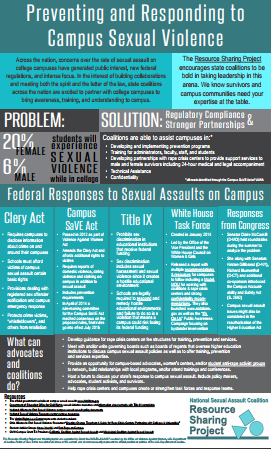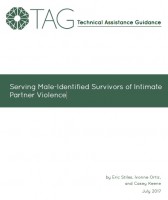Resources Library: Multidisciplinary
Start a Search:
RSP Preventing and Responding to Campus SA Infographic

In this ReShape, the Resource Sharing Project created an infographic for coalitions about federal rules and regulations around campus sexual assault.
Rural and Tribal Elder Justice Resource Guide: Summit Event Briefing
Summit Event Briefing
November 14-15, 2018
Marriott Downtown 700 Grand Ave.
Des Moines, Iowa
On June 15, 2018, the United States Department of Justice and Department of Agriculture committed to working together to promote elder justice in rural and tribal communities. Elder justice refers to a society’s response to elder abuse, which includes physical abuse, caregiver neglect, financial exploitation, psychological abuse, sexual abuse, and abandonment. Each year in America, at least 10% of older adults (age 60 or older) experience one or more forms of elder abuse. This is unacceptable.
The goal of the Summit and subsequent activities is to enhance the ability of elder justice professionals to more robustly respond to the unique needs of older adults residing in rural and tribal communities by sharing best practices and proposing innovative strategies to fill the identified gaps in service needs, all with the goal of enhancing the lives of older Americans everywhere.
SAFE RETURN: Working Toward Preventing Domestic Violence When Men Return from Prison
The Safe Return Initiative focuses on strengthening domestic violence services for African American women and their children when they are facing the return of an intimate partner from prison. It does this by building culturally specific technical capacity within and cooperation among justice institutions and community-based and faith-based organizations. Its goals are to keep women and their children safe and improve the odds of successful reentry by offering peer-based learning, training, information sharing, and on-site assistance designed to help criminal justice and community-based
organizations better serve African Americans dealing with prisoner reentry.
Securing Devices and Accounts - a new resource from NNEDV and Norton

NNEDV is excited to announce a new resource in partnership with Norton (yes, the folks who do data security). Their new resource "Securing Devices and Accounts" is a privacy-and-security-focused guide for survivors of abuse, stalking, and other gender-based violence.
You can read more about the partnership and the resource launch on Norton’s blog and download the resource below.
Serving Male-Identified Survivors of Intimate Partner Violence

"Historically, domestic violence programs were born from the women’s liberation movement of the 1970s to address the needs of female survivors, who still represent the majority of victims seeking services today. Generally, the domestic violence movement has framed its work on a gender binary with men as perpetrators and women as victims. We have come to learn, however, that a woman-centered approach to advocacy only addresses the needs of a portion of survivors and largely fails to acknowledge and address male victimization."
A resource developed by the National Resource Center on Domestic Violence, this Technical Assistance Guidance supports advocates seeking to build capacity to recognize and respond to survivors across the gender spectrum, while honoring the gender analysis that helps us understand the root causes of violence and oppression.

